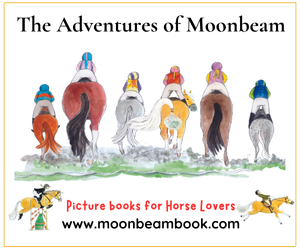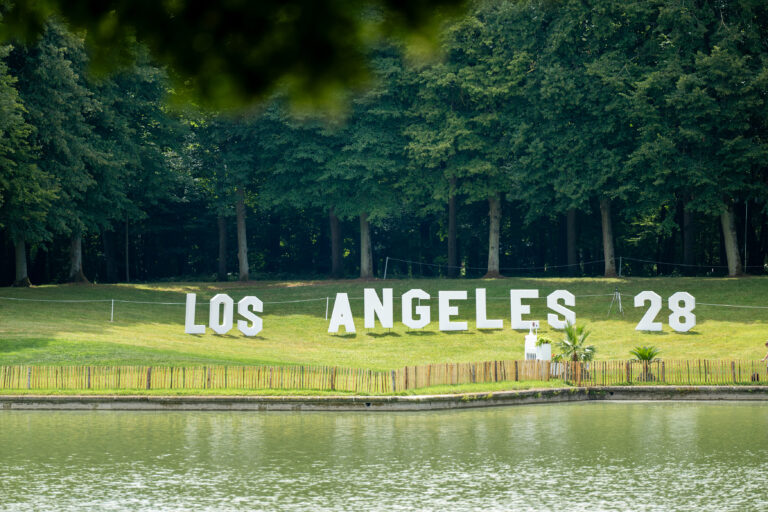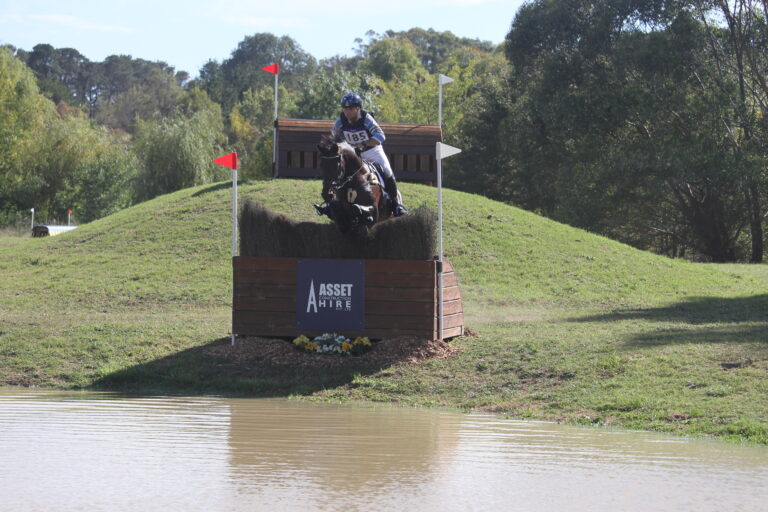Tristan has been flying the Australian flag in Europe for many years now.
© TRT Method
Tristan Tucker launches TRT Live Worldwide
By Equestrian Life
Acclaimed Australian horseman and Grand Prix dressage rider, Tristan Tucker, is taking the concept of virtual training to a whole new level at the end of this month with a much-anticipated global clinic.
Dubbed ‘TRT Live Worldwide’, the clinic will showcase Tristan’s TRT Method – which has garnered praise from many of the sport’s top riders and coaches.
“On November 28, I’ll be showing you how to solve all kinds of behavioural problems your horse might have,” explains Tristan.
“I’ll take you along in the process of using the TRT method so your horse will become a good decision-maker instead of just relying on his natural instinct of flight.”
Tristan explains that it’s not just for dressage riders. “You should really join us if you want to learn more about mentally training your horse, no matter what discipline!”
Uptake of tickets to date as exceeded expectations, with Tristan explaining that he’s even received a notification from Guinness World Records stating that a milestone could in fact be reached.
“It’s going insane. We had notification that there is a Guinness World Record for the most amount of people that had been live on the internet at one time; it was a business conference that did 12,500 people, and that was an official record.
“We have 10,000 members as part of our online training, so the record is totally reachable, which would be incredibly insane if we held that record through a horse event! Quite a community achievement!”
The details:
Join from home (you’ll receive an email link) and also gain access to a replay if you can’t join the full live event or wish to rewatch sections.
NOVEMBER 28, 2020
7 pm CEST (Netherlands)
1 pm UTC-4 (Miami, USA)
5 am UTC+11 (Melbourne, Australia) (Note: Nov 29!)
Tickets are just €29 (approx. AUD $48).
Tristan is kindly providing the winners of each class (Preliminary to Advanced) in Equestrian Life’s November virtual competition with tickets to TRT Live Worldwide!
So who is Tristan Tucker?
For those who don’t know, Tristan Tucker is an Aussie dressage rider and horsemanship expert based in the Netherlands. In the Jan/Feb 2018 edition of Equestrian Life magazine, we caught up with Tristan to find out more. Revisit the article below:
THE ENIGMA OF TRISTAN TUCKER
By Sunday Batters
Equestrian Life, Jan/Feb 2018
Acclaimed Australian horseman Tristan Tucker has built a huge world following for his unique TRT Method of training – and almost as big a following for his alter ego, the hilarious Brett Kidding.
As a trainer best known for his TRT Method, Tristan’s focus is on making every horse confident and relaxed. His ability to achieve this has come from a lifetime of learning from a range of sources, self-reflection and respect for the horse. Based at his own stables at Langeboom in the Netherlands since 2011, Tristan’s TRT Method has taken off around the world after he launched it in 2015, and dressage riders are riding quieter and more confident horses as a result. But just when you think this Aussie upstart is at the forefront of serious training, he trots out Brett Kidding and uses humour to demystify dressage with a Grand Prix spoof. Here, we meet both the serious Tristan Tucker and the not-so-serious Brett Kidding.
EQ LIFE: Tristan, what made you leave Australia?
TRISTAN: It’s a good question. I had a very good business and very good clients and more than enough horses to work. But it’s kind of like anything in life – I saw myself continuing to just keep doing what I was doing. I was lacking a connection with basically the top sport and horses and riders and trainers in Europe, and missing that inspiration of being constantly challenged to better myself. I needed to put myself in the position where I had all those influences. I had originally planned to go for up to two years – and that was 10 years ago.
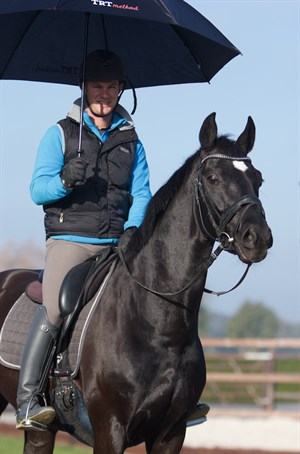
Tristan Tucker is not afraid to do things differently.
© TRT Method
EQ LIFE: What did you aim to do when you first arrived in Europe?
TRISTAN: I first came to Europe at the end of ’99 for a year, and I was with my trainer there in Denmark, Morten Thomsen. When I returned again to Europe, I went back to his stable and began riding for him. I bought three horses with me from Australia.
EQ LIFE: What was your plan?
TRISTAN: I had a grey horse that was doing Grand Prix, and the idea was to bring him to Europe and just further my education in riding and training and teaching horses. I never had big aspirations to ride competitively or go to the Olympics. The mentors I had, they had also ridden at a high level, but their main focus was on the education and understanding of horses, so my mentors influenced me in that way that I really enjoy the teaching and training and studying of horsemanship. Horsemanship is now branded a little bit as a marketing word, but horsemanship at its basic is to better understand yourself so you can better educate your horse.
EQ LIFE: Are you actually competing?
TRISTAN: Yes, I am now. I have some quite exciting horses. I have the first son of Weihegold (Isabell Werth’s champion mare), an eight-year-old who’s just started international shows. I have now some horses where I really have the feeling that I want to compete and show what I’m teaching the horses, and how positive the horses can be. Actually, it is a development of myself to further refine my riding skills in performance, and to help the horses that I’m having in training. Sir Weihbach, that I have now, he also came to me, like most horses, with issues. He has a bit of performance anxiety, and it’s a challenge for me because most of the time with horses with those issues I can solve fairly quickly. He has deep-seated issues from being a breeding stallion, so we have those kinds of exciting tests where he’s screaming out to the other horses and has separation anxiety. That’s just another journey for me to take, another horse from one position to another. Hopefully, he improves and grows and develops along the way.
EQ LIFE: How did you start TRT Method and what does it stand for?
TRISTAN: They’re my initials – Tristan Ross Tucker. It’s basically a development of all the knowledge that I’ve gathered along the way. I spent eight years in Nar Nar Goon (Victoria) breaking in up to 100 horses a year, and that’s a huge learning curve for me of what to do and what makes sense to the horses the most.
The longer I spend in Europe, the more different trainers I’ve been able to access. I’m basically trying to take knowledge from everywhere that I can. So, it is through my background of horsemanship, and getting horses to be able to understand their job and their purpose. I came to Europe and I applied that in learning theory, the horses learning and being educated for the sport. The big contrast, of course, is in Europe they have a history of a technical aspect of riding — their focus is learning through a technique of riding, learning how to fit.
My background is learning about the horse – how he is functioning and how he understands how to learn something, and how I can give him a good understanding of the world he is born into and what his purpose is, and that he has the knowledge and skills to be able to exist happily.
EQ LIFE: You have an online programme, but can people come to you to commence the programme in person, or do they come to your seminars? How do you get your message across?
TRISTAN: The online training started basically because there are only so many hours in the day! I could have given 12 lessons a day, 365 days a year. I was trying to figure out how I could reach and help more people, even if it is only planting a seed or an idea. From the beginning it was a real success and I think it has a lot to do with people having to take responsibility. They actually go to the computer and watch the video set up as a three-module course, and a foundation, so people can watch the lessons then go and practise. You can also have it on your phone and look back and think, “Oh, this is what I have to do’’. You have something to refer back to.
I think you can tell someone 100 things in a lesson and when they drive away, they remember 10, and two days later, they remember two. If they have something to refer back to, it can be a better system for learning. We also have a live Q&A every month so all the members can log on. People send in their videos and I give one-on-one support. Everyone logged on also sees the videos, and some will relate to a similar problem or where they want to progress.
And then you have the large clinics such as TRT Live! We’re travelling around and demonstrating the method both in a masterclass form and giving lessons to people that sign up. We still take horses in training, but most of the time we try first to get people to refer themselves to the online training – that they have a good understanding of what we’re teaching here. They also have the option to come here to get one-on-one help if the horse is at a level that they are not able to find success through self-learning via the online method.

Tristan working with a horse at a clinic in Australia.
© Roger Fitzhardinge
EQ LIFE: Do many people come across the platforms, e.g. do online, visit you in person and also do your masterclasses?
TRISTAN: Yes, absolutely. We’re in 38 different countries now. I think we have nearly four million followers and over 3,000 full-time members, so there’s a big range of people from all over the world. When I go to the US and I give the clinics there in Florida, and Connecticut and Boston, there’s probably 60 per cent who are doing the online training. And of course, there are the people in the Netherlands and Germany who come for private lessons or to the TRT days that we have here at home. That’s an opportunity for members to come on one day with a lot of other members who are doing the online training, and they have a 45-minute private lesson. They’re here the whole day training, workshopping, swapping ideas and talking about their horses, watching all the lessons and absorbing as much information as they can.
EQ LIFE: You must get such a buzz from seeing people taking your learnings and actually being able to improve themselves and their horses?
TRISTAN: Yes, that’s the biggest buzz… it’s really about the contribution, the people who are interested and want to really learn something with their horses. That you can provide and offer something is really what gives you satisfaction and fulfilment and energy. I try to do more and more of the things in life that give me energy, not take energy from me. You build momentum with that kind of thing. We have on a daily basis people who send videos in of a horse that they hadn’t been able to get on the trailer for three years – and the horse is walking in by itself, and the people are crying in tears, overjoyed. It’s definitely some of the most rewarding time I’ve had in my life.
EQ LIFE: Tristan, what made you start Brett Kidding?
TRISTAN: Brett came about when I was asked by Richard Davison and Carl Hester – they run a dressage convention there in the UK every year – and they asked if I’d come and give a demonstration. They’re very liberal and easy-going guys. I came up with the idea because I was doing a lot of clinics in Germany, in places with a strong history of tradition, where you have to say things in a certain way. You have to present things in a certain way, you have to be very diplomatic. Almost at the beginning of a demonstration, you say things in a way that it sounds like what they would say to get an opening. That way you are able to open the minds of people there to take in the real message that you are trying to say. It was never that I was saying this was gospel and this is what is right, and what somebody else is doing is wrong. I always present things in a way that works for me.
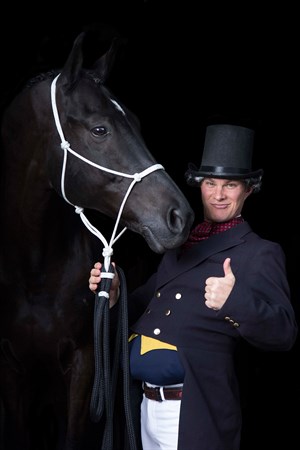
The famous “Brett Kidding”.
© cfotos.nl
I also find being in Europe that some aspects of dressage can be very serious and I have the feeling that they sometimes suppress my natural humour. Brett was created from all these sorts of situations and feelings and scenarios. I wanted to portray something that everyone could identify with, that everyone knew from that first Grand Prix that I rode.
EQ LIFE: I wept with laughter. You just hit every nail on the head with what we horse people think.
TRISTAN: Through humour you can give self-reflection. Everybody can identify with it. Because it’s humorous, nobody is ever ashamed to say, “Oh yes, God I’ve done that or I’ve thought that or that’s happened to me’’. Humour opens people up to be able to look at themselves and think that actually it’s okay that things are done wrong and that maybe the horse doesn’t understand what’s going on a lot of the time. It is important to ask yourself all the time, “Who is my horse and what is he thinking?”
It’s also a way of saying that it’s okay. Nobody sets out to do anything wrong by their horse or themselves. By saying it’s okay and that we can laugh at it, it opens the door to self-reflection and being able to say the things in the industry that nobody says out loud. If it’s not said, if everybody is afraid or thinks they should be presenting themselves in a certain way to be successful, nobody is staying true to themselves and the whole industry becomes a lie, which makes every part of it frustrating. It’s about being as true to yourself as possible and encouraging others to do the same.
EQ LIFE: Have you found it challenging breaking into this market?
TRISTAN: Yes, of course, in the beginning I went through a lot of stages of restarting – being in Denmark and not being known by anybody, taking risks financially, sleeping in stables and having nothing, and building up a name to be able to be yourself and begin somewhere. Coming to the Netherlands was probably the hardest because I came when they were very successful. They had Edward Gal and the history of Anky Van Grunsven, all these top riders.
Everybody aspired to be these riders, and how could it possibly be that an Australian guy, this guy coming in waving some flags around, would know anything better than the people who have proven themselves and have the gold medals?
That was difficult, but I didn’t focus on the accolades and material things, I didn’t try to be something that I wasn’t. I didn’t try to compete and I didn’t portray myself in a way that I thought would get me attention or clients or success. I just tried to be myself and kept pushing the ideas that I really believed in. I kept following the passion myself and improving myself, and trying to share that with anyone who wanted to know it.
When you come from a totally different background, it is an advantage in some way. You stand out, you’re the oddball, you’re doing these weird things. In the beginning, when I was going to the Internationals and I had students there, I was there because their horses were spooky in the indoor shows or the big World Cup arenas. When you’re hand-walking a horse in the arena familiarisation at a World Cup show, with a rope halter on, and you’re stopping and teaching the horse to control his own heart rate, setting a pattern that he can relax in the arena… I mean, everybody is looking at you – not just the general public, but the best riders in the world, the best trainers in the world – they’re all looking at you like you have something growing out the side of your head and automatically dismissing you because it’s different.
Then the horses had quite big turnarounds; horses with a reputation of being fractious and spooky and unpredictable started to get consistent scores and become really stable in the arena and enjoy the performance. The media starts to pay attention and then the word gets spread around.
The main focus always for me is to continue and follow what you believe in. And actually, there’s quite a big level of just not giving a f —. If you care a lot about what other people think, it’s taking you away from the natural line of progression that you need to be on. There’s a big deal of that – not caring.
EQ LIFE: Well, great credit to you, Tristan. Congratulations.
READ THE LATEST NEWS ARTICLES HERE





